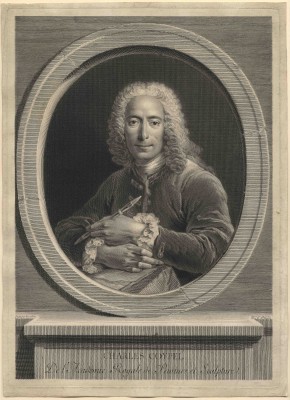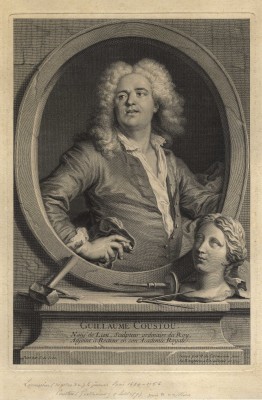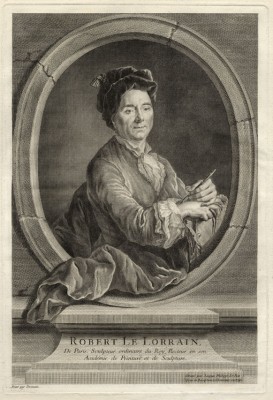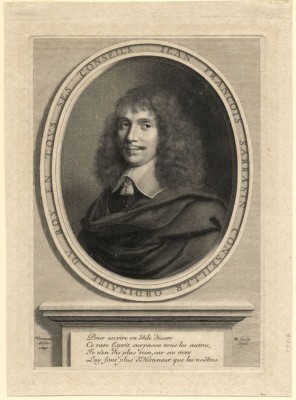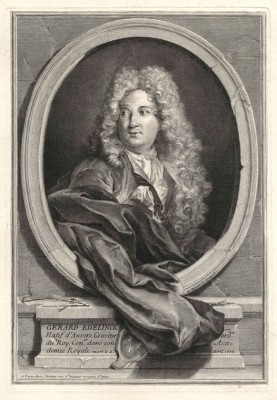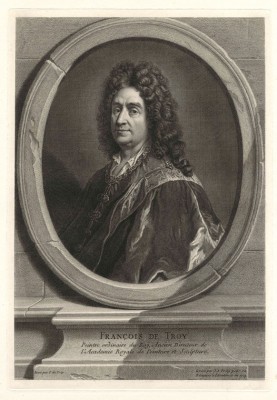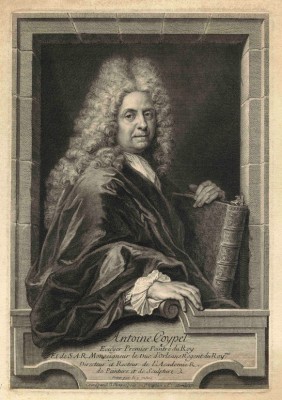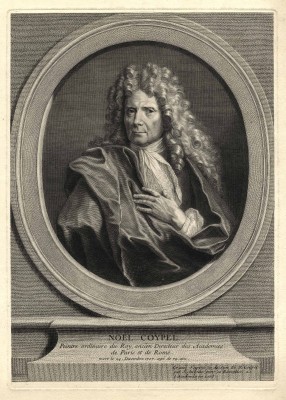FRENCH PORTRAIT PRINTS
French portrait prints of the seventeenth and eighteenth centuries have always been treasured by print collectors through the ages. Nowadays, however, they have fallen out of fashion to much the same degree as their subjects. Perhaps a review is in order. These images do not merely represent absolute rulers, or the vain posing of artists who played to the taste of their times. Instead we might see these prints as the results of a series of brilliant technical accomplishments that allowed them to ascend from the realm of craft to that of art. Louis Metcalfe wrote in 1912, for example, of Robert Nanteuil’s works: “Nothing more admirable has been done in the realm of engraving than these quiet prints in which there is no affectation […] and it is a question whether anything more sincere has been accomplished in the history of portraiture.”

Click images to toggle info
-
![]()
GASPARD DUCHANGE
1662 – Paris – 1757
Portrait of the Sculptor François Girardon 1707
engraving; 356 x 255 mm (14 x 10 1/16 inches)
Le Blanc 38; Inventaire du fonds français (XVIIIe siècle) 9 second (final) statePROVENANCE
Roland de Perthuis (not in Lugt)The inscription gravé par Duchange pour sa Réception a l’Académie en 1707 states that this print was submitted by Duchange’s for his admission to the Royal Academy.
The print is based on a painting by HYACINTHE RIGAUD (1659 Perpignan – Paris 1743), arguably the greatest portraitist of the early eighteenth century.
The celebration of the reign of Louis XIV was the most important subject for the sculptor FRANÇOIS GIRARDON (1628 Troyes – Paris 1715). It is not without irony, therefore, that he died on the very same day (September 1, 1715) as his king.
-
![]()
SIMON-CHARLES MIGER
1736 Nemours – Paris 1820
Portrait of the Painter Joseph Marie Vien 1790
engraving; 373 x 254 mm (14 11/16 x 10 inches)
LeBlanc 38WATERMARK
large coat of armsMiger became a member of the Académie royale in 1781. He dedicated this print to the academy in 1790.
The engraving is based on a pastel by ADÉLAIDE LABILLE-GUIARD (1749 – Paris – 1803) who is here, in 1790 (!), still titled as peintre du Roi and peintre de Medammes (painter of the French princesses). Her portraits of the various members of the academy, this one among them, were exhibited at the Salon in 1783.
The painter and etcher JOSEPH MARIE VIEN (1716 Montpellier – Paris 1809) was a prominent figure in pre-revolutionary France. After winning the Prix de Rome in 1743 he went to Italy and became a witness to the excitement created by the excavations in Herculaneum. Only toward the end of his career he was able to free himself from the conventions of the Rococo and to adapt the new neo-classical style that was introduced by his most important pupil Jacques-Louis David.
-
![]()
JEAN-JOSEPH BALECHOU
1719 Arles – Avignon 1764
Portrait of the Painter Charles Coypel 1749
engraving, 387 x 278 mm (15 1/4 x 10 15/16 inches)
Le Blanc 48; Inventaire du fonds français (XVIIIe siècle) 44PROVENANCE
Solimon 1838 (inscription in pen and brown ink, twice, on the reverse, not in Lugt)
Ambroise Firmin-Didot, Paris (Lugt 119)
Roland de Perthuis (not in Lugt)This engraving is the morceau de réception à l’Académie” of Jean-Joseph Balechou in 1749.
In 1752 Balechou made a portrait print of King August III of Poland based on a painting by Rigaud. Against his promise he had kept impressions of the print for himself. When found out, he was evicted from the academy, fled to Avignon and committed suicide.
The painter CHARLES-ANTOINE COYPEL (1694 – Paris – 1752) can be counted among the most important French artists of the first half of the eighteenth century. Peintre du Roy from 1746 and director of the academy from 1747 he was highly influential. The self-portrait that formed the model for Balechou’s print is now in the Louvre.
-
![]()
LAURENT CARS
1699 Lyon – Paris 1771
Portrait of the Sculptor Michel Anguier 1733
engraving; 357 x 245 mm (14 1/16 x 9 5/8 inches)
Le Blanc 20; Inventaire du fonds français (XVIIIe siècle) 33 second (final) statePROVENANCE
Roland de Perthuis (not in Lugt)With the inscription Gravé par Laurent Cars pour sa reception à l’Académie en 1733 below, stating that this print was submitted by Cars to obtain his admission to the Royal Academy.
Practicing both painting and engraving Cars later gave up the former to concentrate solely on printmaking.
The print is based on a painting by GABRIEL REVEL (1642 Château-Thierry – Dijon 1712) who became a member of the Académie royale in 1683.
The sculptor MICHEL ANGUIER (1612 Eu – Paris 1686) worked for ten years in Rome. He became a member of the Académie royale in 1668; the same year he became first teacher, then in 1671 director at the Académie des Beaux-Arts.
-
![]()
NICOLAS DE LARMESSIN IV
1684 – Paris – 1755
Portrait of the Sculptor Guilleaume Coustou the Elder 1730
engraving; 362 x 253 mm (14 1/4 x 10 inches)
LeBlanc 57; Inventaire du fonds français (XVIIIe siècle) 40WATERMARK
dovecoteWith the inscription Gravé par N. de l’Armessin pour sa reception à l’Académie en 1730 in the lower right corner, stating that this print was submitted by Larmessin to obtain his admission to the Royal Academy. At the time of his death, Larmessin held the titles graveur du Cabinet du Roi et de son Académie royale.
The print is based on a painting by JACQUES FRANÇOIS DE LYEN (1684 Gent – Paris 1761) from 1725, the same year that De Lyen had painted the portrait of Bertin that was engraved by Lépicié.
The sculptor GUILLAUME COUSTOU (1677 Lyon – Paris 1746) won the Prix de Rome in 1697. He became a member of the Royal Academy in 1704, was appointed professor in 1715 and ultimately its director in 1735.
-
![]()
JACQUES-PHILIPPE LEBAS
1707 – Paris – 1783
Portrait of the Sculptor Robert de Lorrain 1741 engraving; 380 x 260 mm (14 15/16 x 10 1/4 inches)
LeBlanc 168; Inventaire du fonds français (XVIIIe siècle) 149 second state (of three)PROVENANCE
Roland de Perthuis (not in Lugt)An impression of the second state; in the final state the inscription at lower right – Gravé par Jacques-
Philippe Le Bas pour sa Réception à l’Académie en 1741 – was cancelled. LeBas was especially influential as the teacher of the best French engravers of the second half of the eighteenth century.The print is based on a painting by Hubert Drouais (1699 La Rocque near Pont-Audemer – Paris 1767) who specialized in miniature portraits.
The sculptor ROBERT LE LORRAIN (1666 – Paris – 1743) won the Prix de Rome in 1689 and became a member of the Royal Academy in 1700 where he became a director in 1737.
-
![]()
BERNARD LÉPICIÉ
1698 – Paris – 1755
Portrait of the Painter Nicolas Bertin 1740
engraving; 373 x 260 mm (14 11/16 x 10 1/4 inches)
LeBlanc 18; Inventaire du fonds français (XVIIIe siècle) 54 second (final) stateWith the inscription Gravé par Bernard Lépicié pour sa reception à l’Académie en 1740 in the lower right corner, stating that this print was submitted by Lépecié to obtain his admission to the Royal Academy.
The engraving is based on a painting by the painter and engraver JACQUES FRANÇOIS DE LYEN (1684 Gent – Paris 1761). The painting, dating from 1725 (the same year as his portrait of Coustou that was engraved by Larmessin), is not only one of the major works by the artist. It is also one of the most famous French artist portraits of the early eighteenth century. De Lyen became a member of the Académie royale in 1725 and court painter to Louis XV in 1728.
The history painter NICOLAS BERTIN (ca. 1667 – Paris – 1736) became a member of the Académie royale in 1703.
-
![]()
ROBERT NANTEUIL
1623 Reims – Paris 1678
Jean François Sarrazin 1656
engraving; 215 x 152 mm (8 7/16 x 5 15/16 inches)
Robert-Dumesnil 220; Petitjean/Wickert 203 first state (of five)PROVENANCE
Ducs d’Arenberg, Brussels and Nordkirchen, Westphalia (Lugt 567)It is unusual for Nanteuil to also give the date of the drawing. Here, he explicitly signs the print as delin[eavit] 1649 et sculp[sit] 1656.
-
![]()
NICOLAS-ETIENNE EDELINCK
1681 – Paris – 1767
Portrait of the Engraver Gerard Edelinck
engraving; 367 x 256 mm (14 7/16 x 10 1/16 inches)
LeBlanc 10; Inventaire du fonds français (XVIIIe siècle) 2 second (final) statePROVENANCE
Henri Béraldi, Paris (Lugt 230)
Roland de Perthuis (not in Lugt)Nicolas Etienne was the eight child of GERARD EDELINCK (1640 Antwerp – Paris 1707), one of the
foremost French portrait engravers of the seventeenth century. Nicolas was trained by his father.This print, a portrait of his father, is probably his most important work. It is based on a painting by JEAN TORTEBAT (1652 – Paris – 1718).
-
![]()
JEAN-BAPTISTE POILLY
1669 – Paris – 1728
Portrait of the Painter François de Troy 1714
engraving; 362 x 252 mm (14 1/4 x 9 15/16 inches)
Le Blanc 40PROVENANCE
Roland de Perthuis (not in Lugt)The print was submitted by Poilly for his admission to the Royal Academy. It is inscribed at lower right:
Gravé par J. B. Poilly pour sa Réception a l’Académie en 1714.The model for the print was a self-portrait by FRANÇOIS DE TROY (1645 Toulouse – Paris 1730).
-
![]()
JEAN-BAPTISTE MASSÉ
1687 – Paris – 1767
Portrait of the Painter Antoine Coypel 1717 engraving; 358 x 248 mm (14 x 9 3/4 inches)
Robert-Dumesnil, vol. 6, p. 347, no. 1; Le Blanc 2Massé was a miniaturist, history painter and engraver. A pupil of Jouvenet and Châtillon he later became
the teacher of Liotard. With the submission and acceptance of the present print, Massé became a member of
the Académie royale in 1717.The print is based on a self-portrait of the royal painter ANTOINE COYPEL (1661 – Paris – 1722).
-
![]()
JEAN AUDRAN
1667 Lyon – Paris 1756
Portrait of the Painter Noël Coypel 1708
engraving; 370 x 263 mm (14 9/16 x 10 3/8 inches), large margins
Le Blanc 355; Inventaire du fonds français (XVIIIe siècle) 27 second (final) stateThis engraving of 1708 is Audran’s morceau de réception a l’Académie as stated in the inscription at the lower right.
The painter Noël Coypel (1628 – Paris – 1707) was the founder of the artist dynasty Coypel. The print is based on a self-portrait drawing by the artist.




